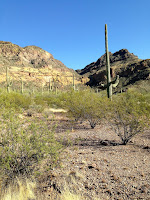A week ago we spent two nights in Ft. Worth, TX, at Sharon and Gary's. (Sharon is Michael's sister.) The weather was superb. 75ish, sunny, not a cloud in the sky. Saturday afternoon Emma and Henry (Sharon and Gary's grandchildren : 5 yrs. and 16 mo.) along with their parents came over to play. Imagine Nina's excitement to have two short ball throwers in the backyard!!
We left Ft. Worth Sunday morning, heading west on I-20. Our plan was to NOT go south to Big Bend Nat. Park this year. We thought we'd do more of New Mexico - like Roswell, the somewhat famous site of UFO crashes in 1947. However a glance at my weather app told me decisively that Roswell, Alamogordo and really all of NM, along with western Texas was headed for a giant dive in night time temps. Forecasts showed 21, 22 23 degrees for those parts the next few nights. In fact, the only places it was predicted to stay even close to 30 were in southern Texas.
Another plan change! We happened to camp that night (the last warm night) near Colorado City, TX, at Colorado City Lake State Park. A smallish road ran south from there. (Michael LOVES driving on the gray roads! ((gray on the map))) The next morning we took it.
Tuesday night we stayed at Seminole Canyon near Comstock, TX, site of cliff dwellings and petroglyphs. We had spent time there last year touring the canyon. A beautifully warm late afternoon and evening awaited us there, warm enough for shorts and dinner outside. And then the BIG BLOW! That gray layer that had covered the sun at sunset making the sun visually disappear into nothingness on the horizon? That layer? That must have been the dusty wind that was headed our way. Holy cow! What a blow! Not much we could do but sit in our rocking motor home listening to the wind whooshing and whistling around us. By 9:00 pm it was over. The temperature had dropped 14 degrees. We put our shorts away.
The next two nights we stayed in Big Bend, one night at Rio Grande Village campground and the next night on the other side of the park at Cottonwood Campground. The afternoons were sunny and 55ish. The nights were chilly, a little less than 30. Since there are no electrical hookups at Big Bend, we relied on our trusty propane furnace to warm us in the mornings.
It's been dry at Big Bend. That area has received none of the
el Nino rains this winter. So the pond/water habitat at Rio Grand Village is a quarter of the size it was last year. And the ocotillos dotting the hillsides along the river look grayish-dead showing no color at all. The river itself at that point separating Mexico from the U.S. is little more than a stream.
Leaving the Rio Grande behind, we drove north and spent our last night in TX at Davis Mountain State Park, one of the "darkest" areas in the U.S. and home of unbelievable night time star displays. Now this is at a higher elevation and we knew it was going to be cold. It was. The morning temp yesterday was 18!!! However, we were plugged in. We had our electric heaters running and Michael and antifreezed the macerator.
We've said our good-byes to Texas for this year. Warmth awaits us in Arizona!?!
  |
| Rio Grande River, Big Bend |
 |
| Chizos Mountains, Big Bend |
 |
| Texas countryside |
 |
| Ditto |




































